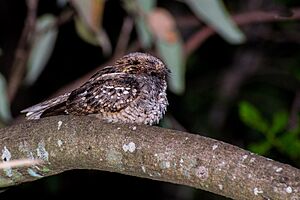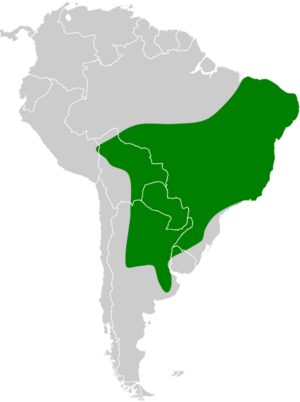Little nightjar facts for kids
Quick facts for kids Little nightjar |
|
|---|---|
 |
|
| Conservation status | |
| Scientific classification | |
| Genus: |
Setopagis
|
| Species: |
parvula
|
 |
|
| Synonyms | |
|
Caprimulgus parvulus |
|
The little nightjar (Setopagis parvula) is a small, interesting bird that flies mostly at night. It belongs to a group of birds called nightjars. You can find this bird in several countries in South America, including Argentina, Bolivia, Brazil, Paraguay, Peru, and Uruguay.
Contents
About the Little Nightjar
Scientists give every living thing a special name. The little nightjar was first named Caprimulgus parvulus. But in the early 2010s, scientists decided it fit better into a different group, so its name changed to Setopagis parvula. Sometimes, other birds like Todd's nightjar and Anthony's nightjar were thought to be the same as the little nightjar, but now we know they are different species. The little nightjar is currently considered a unique species, meaning it doesn't have different types or subspecies.
What Does It Look Like?
The little nightjar is about 19 to 21 centimeters (7.5 to 8.3 inches) long. That's about the length of a standard pencil! It weighs between 25 and 46.5 grams (0.9 to 1.6 ounces), which is lighter than a small apple.
Male little nightjars are mostly grayish-brown. They have cool patterns of buff, brown, and blackish-brown spots and streaks. Their belly is a buff color with brown stripes. Around their neck, they have a wide, light-colored collar that isn't always easy to see. Their chin is buff, and their throat is white. When they fly, you might spot a wide white band on their wings and white tips on their outer tail feathers.
Female little nightjars look quite similar to males. However, their throat is buff-colored instead of white. Also, they don't have the white markings on their wings and tail that the males do.
Where Does It Live?
The little nightjar lives in a large area of South America. You can find it from eastern Peru, across Bolivia, and through central and northeastern Brazil all the way to the Atlantic coast. It also lives south through southern Brazil, Paraguay, and Uruguay, reaching central Argentina. Once, a little nightjar was even seen far away in Aruba!
In the southern parts of its home, and possibly in Peru, these birds are thought to be migratory. This means they travel to different places depending on the season. They might move north and east during the southern winter.
The little nightjar likes places with brushy savanna, which are grasslands with scattered shrubs and trees. It also lives inside and along the edges of open woodlands and forests. Sometimes, you can even find them in plantations of Eucalyptus trees, which are not native to the area. They can live anywhere from sea level up to about 1,500 meters (4,900 feet) high in Bolivia.
Behavior
What Do Little Nightjars Eat?
The little nightjar is a nocturnal bird, meaning it is active at night. It hunts for insects. It often flies out from the ground or a low branch to catch its prey. It might also catch insects while flying continuously, just like some other nightjars do. While we don't know all the details of its diet, scientists have found that it eats insects from at least five different groups.
Reproduction and Life Cycle
The time when little nightjars lay eggs and raise their young can be different depending on where they live. Breeding activity has been seen between August and January. The female usually lays two eggs directly on the ground. Both the male and female birds help to keep the eggs warm until they hatch.
What Does It Sound Like?
The song of the little nightjar is quite unique! It's described as a "rattling, clacking, flat, unbirdlike sound." People often describe its pattern as hurr-ee quick quick quick quick quick quick.
Status of the Little Nightjar
The International Union for Conservation of Nature (IUCN) checks on how many animals are left in the wild. They have assessed the little nightjar as being of "Least Concern." This means that the bird is not currently in danger of disappearing. It lives across a very large area, and even though we don't know the exact number of birds, scientists believe its population is stable. This is good news, as no major threats to the little nightjar have been found.


